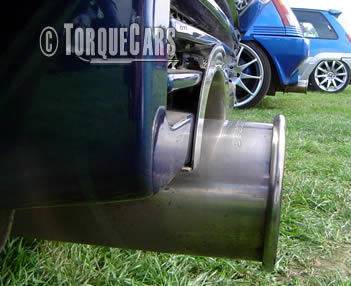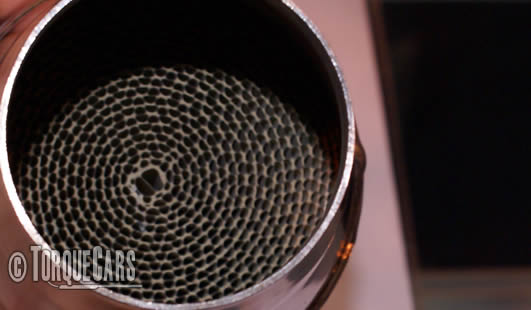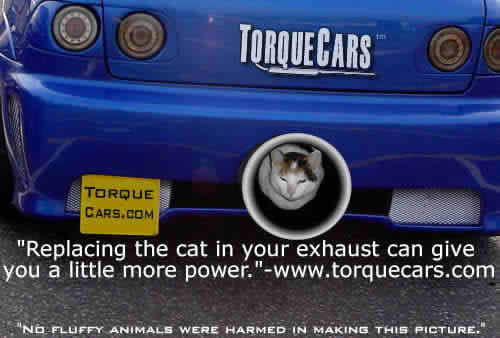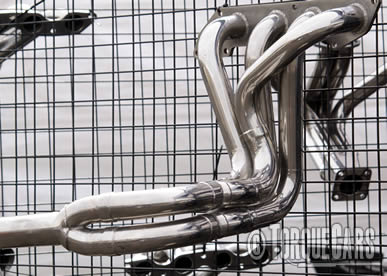Sports exhaust design and performance gains.
"Blow that - exhausting stuff."

TorqueCars will take a look at sports exhausts as they are very popular modifications, but sadly many mistakes are made.
The job of the exhaust is to break up the sound pulse from the engine, muffling the sound and allowing the exhaust gases to escape efficiently.
We see the young lads fitting drainpipe size exhausts and will examine the cause of power losses in these cases.
What effect do they have on the engine and do all exhausts increase power?
This component affects the Blow phase of combustion - getting rid of the exhaust fumes is important and the less pressure there is in the exhaust system the higher the BHP produced.
However, the rate of flow or velocity of the exhaust gases also comes into the equation. Big exhausts slow up the flow and smaller ones increase it. You have to balance the exhaust with the intake and engine capacity to give the best flow rate without causing back pressure (a delay of exhaust gases unable to escape quickly.)
Ideally you will have a different bore size for each RPM band in the engine, but this is not practical, so an optimum all round setting is selected. Most good quality performance aftermarket exhausts move the optimum to work more effectively at higher RPM.
Interestingly some performance car makers have a "dual bore size" exhaust which varies according to the RPM allowing low down Torque and better peak power figures. The flow rate is generally controlled with a mechanical valve or butterfly valve.

The silencer is often the biggest bottleneck in a car. Conventional exhaust filter the exhaust gases round numerous S shapes and through baffles to deaden the noise. A sports silencer is generally a straight pipe with holes in it. The sound waves go through the holes to the outside casing and then bounce back and if done right this cancels a lot of the noise in the exhaust.
Polishing the inside of the exhaust will aid the fast exit of gases as there is less internal friction. This is why a steel header flows better than a cast iron one due to the pits and imperfections left in the casting process.
We hate to see street cars with massive exhausts and we hope the following suggestions will help common sense to prevail. Typically the exhaust is based on the amount of air an engine needs to expel and this varies greatly in turbos and highly tuned engines.
To try to deter our younger readers from sticking the largest exhaust they can find we add the following general tip. As a very very general rule of thumb, under a 1.6l engine, TorqueCars recommend you stick with a maximum 1.5 to 2 inch pipe (the smaller the engine the smaller the bore size). Under 2.5l engines go with 2-2.5 inches and over this go with a 3 inch exhaust.
Over 2.5 liter engines we would suggest a twin exhaust system using half the engine size to determine the optimum pipe size as we have just outlined. so a 3.0 Engine would be ideally suited to a twin 1.5-2 inch bore and 5 litres with a 2-2.5 inch twin bore.
This bore size applies to the minimum bore size throughout the length of the exhaust right up to the back box and tail pipe.
(The back box & exit pipe can be a little wider but this will not release more power, it will just give a deeper sound.).
Gases flow better from a large pipe to a small pipe if the join is cone shaped. Steps will cause turbulence and this can interfere with the airflow and affect performance.

The shape of the exhaust header/manifold (painted red in picture) is also critical as is the primary and secondary length.
This is something best left to the experts to calculate – most manufacturers do a reasonable job.
Aftermarket performance exhaust headers will obviously be better.
However you can improve a standard exhaust by smoothing out the inside with a grinding wheel on a drill. Alternatively buy a purpose built stainless steel unit for your car.
The best systems for a street car are called 4-2-1 which means they go from 4 pipes into 2 pipes and then into 1 in a 3 step process. This will maintain some lower RPM torque. Some very high performance exhausts are 4-1 where all the pipes merge at one point lower down the manifold or 4-2 with two exit pipes. These exhaust allow higher peak power figures and are best suited to a very high average RPM band for example on race cars and Honda VTEC engines.
Cats suck power a little by slowing up the airflow. Catalysts are sadly a requirement on today's cars, there is a typical reduction of 1-4 bhp overall. To minimise this the catalysts are generally twice the bore size of the exhaust which makes up for most of the restriction.

If you find a high flow sports cat or use an off road only de cat pipe you will notice an improvement on most applications.
Although this benefit will be very minimal on smaller engined cars.
There is little difference between a sports cat and a decat and some high performance cars already come with a good quality sports catalyst.
Another option is to go for a 4-2-2 exhaust where you have twin exit pipes with 1 for 2 exhaust ports from the engine.
Most sports silencers add a deep roar to the exhaust but this adds little to the overall experience other than the noise they make. One of the best exhausts I ever had was a standard one (from a larger engined car) with the rear silencer remover – the center expansion section was larger to help muffle the sound but it really improved flow a lot and sounded great. I will note that low down torque was lost with a noticeably higher peak rpm torque band.

TorqueCars recommend the "Cherry Bomb" for simplicity and a deep throaty sound but you will probably need to fabricate your own mounts.
Just as induction length is critical so exhaust length is also vital. You should also aim to have the same exhaust length from each exhaust port.
Most standard exhaust headers (or depending on your location manifolds) are cast and have many imperfections on their internal surface. They often have ridges where surfaces are joined. Grinding and polishing the inside of the exhaust smooth will aid airflow and improve things.

While you are at it you could polish it throughout its length to completely remove resistance. Performance exhausts are made of stainless steel which has a much smoother internal surface and is also much lighter. Attention should be given to the joins and bends, and the fewer the better being the order of the day.
Under bonnet temperature is one of your biggest performance killers see the induction and vents articles for more suggestions. Wrapping the exhaust header/manifold with a heat resistant wrap can yield a dramatic reduction in temperature and will help the cat to reach operating temperature more quickly therefore prolonging its life and efficiency.
(Don't use cloth bandages as this becomes a fire hazard!) The application of a ceramic coating can substantially reduce the transmission of exhaust heat into the engine bay and will keep get the catalyst up to working temperature more quickly.
To find out more about exhausts in general, or to ask which exhaust application would be best for your car, join in the friendly banter in our members forum and discuss exhausts in more detail (and all aspects of car modification).
Tell us about your project - we're always interested to hear what people are doing to their cars.
Please Check out my YouTube channel, we're regularly adding new content...
PLEASE HELP: I NEED YOUR DONATIONS TO COVER THE COSTS OF RUNNING THIS SITE AND KEEP IT RUNNING. I do not charge you to access this website and it saves most TorqueCars readers $100's each year - but we are NON PROFIT and not even covering our costs. To keep us running PLEASE Donate here
If you liked this page please share it with your friends, drop a link to it in your favourite forum or use the bookmarking options to save it to your social media profile.
Feedback - What do You Think?
Please use our forums if you wish to ask a tuning question, and please note we do not sell parts or services, we are just an online magazine.
Help us improve, leave a suggestion or tip
Please watch this video and subscribe to my YouTube channel.
7 Responses to “High performance sports exhausts systems.”

 Click to accept YouTube Cookies & Play.
Click to accept YouTube Cookies & Play.
excellent advise. will help buyers not to waste their money on unsuitable irems.
Hi-my 1000cc Suzuki car comes standard with a 1″ bore for the exhaust system throughout till the tail pipe. I have retained the CAT but removed the muffler, and fitted a 2″ pipe about 5 feet in length. The car sounds great, however whenever I try quick acceleration there is a certain amount of loss in power. But, when I accelerate gradually, the pick up is good. Any suggestions? Thanks.
can any one explain how back pressure effect the car performance……
imagine your lungs as the engine.
now blow thru a large diameter straw.
now blow thru a small diameter straw.
you will notice you can blow thru the small diameter straw longer with more force…
One thing I would add to an excellent article is the following. The main function of primary pipes is to set the initial rpm point (engine speed) at which a torque boost is created, as contributed by the headers. Keep in mind, exhaust and intake systems can be tuned to different engine speeds. By so doing, an overall torque curve can be broadened or narrowed by the separate dimensioning of intake and exhaust systems
In the case of headers, primary-pipe diameter determines flow rate (velocity). At peak torque (peak volumetric efficiency), the mean flow velocity is 240-260 feet per second (fps), depending upon which mathematical basis is used to do the calculation. But for sizing or matching primary pipes to specific engine sizes and rpm, 240 fps is a good number.
Changing the length of primary pipes generally affects the amount of torque produced above and below peak-torque rpm. For example, all else being equal, shortening primary pipes transfers torque from below to above the peak, not significantly shifting the rpm point at which peak torque occurs. Increasing primary-pipe length produces the opposite effect of shortening the length.
There is a program available which allows you to input the VE, the revs most important to you, the engine size, the number of cylinders etc and gives you the power gained or lost through either lengthening or reducing the primarys.
Great article.
How does this vary for NA vs forced induction cars?
sounds like to me the cat doesn’t create to much loss neither does the factory exhaust on a factory set up but im wondering my 2.0 is doing 300 flywheel horse and 330 torque but when I change turbos and head for the 475-500 horse will the factory exhaust still be efficient for this level???